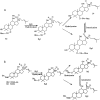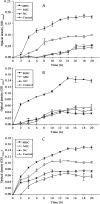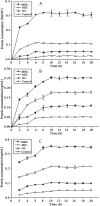Improved antimicrobial effect of ginseng extract by heat transformation - PubMed (original) (raw)
Improved antimicrobial effect of ginseng extract by heat transformation
Peng Xue et al. J Ginseng Res. 2017 Apr.
Abstract
Background: The incidence of halitosis has a prevalence of 22-50% throughout the world and is generally caused by anaerobic oral microorganisms, such as Fusobacterium nucleatum, Clostridium perfringens, and Porphyromonas gingivalis. Previous investigations on the structure-activity relationships of ginsenosides have led to contrasting results. Particularly, the antibacterial activity of less polar ginsenosides against halitosis-related bacteria has not been reported.
Methods: Crude saponins extracted from the Panax quinquefolius leaf-stem (AGS) were treated at 130°C for 3 h to obtain heat-transformed saponins (HTS). Five ginsenoside-enriched fractions (HTS-1, HTS-2, HTS-3, HTS-4, and HTS-5) and less polar ginsenosides were separated by HP-20 resin absorption and HPLC, and the antimicrobial activity and mechanism were investigated.
Results: HPLC with diode-array detection analysis revealed that heat treatment induced an extensive conversion of polar ginsenosides (-Rg1/Re, -Rc, -Rb2, and -Rd) to less polar compounds (-Rg2, -Rg3, -Rg6, -F4, -Rg5, and -Rk1). The antimicrobial assays showed that HTS, HTS-3, and HTS-4 were effective at inhibiting the growth of F. nucleatum, C. perfringens, and P. gingivalis. Ginsenosides-Rg5 showed the best antimicrobial activity against the three bacteria, with the lowest values of minimum inhibitory concentration and minimum bactericidal concentration. One major reason for this result is that less polar ginsenosides can more easily damage membrane integrity.
Conclusion: The results indicated that the less polar ginsenoside-enriched fraction from heat transformation can be used as an antibacterial agent to control halitosis.
Keywords: Panax quinquefolius; antimicrobial activity; halitosis; heat transformation; less polar ginsenosides.
Figures
Fig. 1
Chromatograms. (A) Chromatogram of America ginseng saponins, (B) steamed ginseng at 130°C for 4 h, (C) 60% fraction, and (D) 80% fraction. 1, Rg1/Re; 2, Rg2(R); 3, Rc; 4, Rd; 5, Rg6; 6, F4; 7, Rh4; 8, Rg3(S); 9, Rg3(R); 10, Rk1; 11, Rg5; 12, Rh2.
Fig. 2
Hydrolysis processes from polar ginsenosides to less polar ginsenosides. (A) Hydrolysis process of ginsenoside Re to ginsenosides Rg2, F4, and Rg6. (B) Hydrolysis process of ginsenosides Rb2 and Rd to ginsenosides Rg3, Rk1, and Rg5.
Fig. 3
Nucleic acid absorbance. Release of 260-nm absorbing material from (A) Porphyromonas gingivalis, (B) Clostridium perfringens, and (C) Fusobacterium nucleatum treated with HTS-4 and AGS. AGS, Panax quinquefolius leaf-stem; HTS, heat-transformed saponins; MBC, minimum bactericidal concentration; MIC, minimum inhibitory concentration; NC, negative control.
Fig. 4
Protein release. Release of protein from (A) Porphyromonas gingivalis, (B) Clostridium perfringens, and (C) Fusobacterium nucleatum treated with HTS-4 and AGS. AGS, Panax quinquefolius leaf-stem; HTS, heat-transformed saponins; MBC, minimum bactericidal concentration; MIC, minimum inhibitory concentration; NC, negative control.
Fig. 5
Membrane potential of Porphyromonas gingivalis, Clostridium perfringens, and Fusobacterium nucleatum treated with HTS-4 and AGS. AGS, Panax quinquefolius leaf-stem; AU, absorbance units; HTS, heat-transformed saponins; MBC, minimum bactericidal concentration; MIC, minimum inhibitory concentration; NC, negative control.
Similar articles
- Evaluation of antibacterial and anti-inflammatory activities of less polar ginsenosides produced from polar ginsenosides by heat-transformation.
Wang L, Yang X, Yu X, Yao Y, Ren G. Wang L, et al. J Agric Food Chem. 2013 Dec 18;61(50):12274-82. doi: 10.1021/jf404461q. Epub 2013 Dec 9. J Agric Food Chem. 2013. PMID: 24289140 - Less polar ginsenosides have better protective effects on mice infected by Listeria monocytogenes.
Jing J, Zhang R, Wang Y, Tang S, Yang H, Du L, Lin B, Shao L, Zhang F, Xue P. Jing J, et al. Ecotoxicol Environ Saf. 2021 Apr 15;213:112065. doi: 10.1016/j.ecoenv.2021.112065. Epub 2021 Feb 24. Ecotoxicol Environ Saf. 2021. PMID: 33636464 - Efficient thermal deglycosylation of ginsenoside Rd and its contribution to the improved anticancer activity of ginseng.
Kim YJ, Yamabe N, Choi P, Lee JW, Ham J, Kang KS. Kim YJ, et al. J Agric Food Chem. 2013 Sep 25;61(38):9185-91. doi: 10.1021/jf402774d. Epub 2013 Sep 10. J Agric Food Chem. 2013. PMID: 23984628 - Preparation and bioactivity of the rare ginsenosides Rg3 and Rh2: An updated review.
Xu W, Lyu W, Duan C, Ma F, Li X, Li D. Xu W, et al. Fitoterapia. 2023 Jun;167:105514. doi: 10.1016/j.fitote.2023.105514. Epub 2023 Apr 20. Fitoterapia. 2023. PMID: 37084851 Review. - Ginsenosides are active ingredients in Panax ginseng with immunomodulatory properties from cellular to organismal levels.
You L, Cha S, Kim MY, Cho JY. You L, et al. J Ginseng Res. 2022 Nov;46(6):711-721. doi: 10.1016/j.jgr.2021.12.007. Epub 2021 Dec 22. J Ginseng Res. 2022. PMID: 36312737 Free PMC article. Review.
Cited by
- Effects of American Ginseng Cultivation on Bacterial Community Structure and Responses of Soil Nutrients in Different Ecological Niches.
Chang F, Jia F, Lv R, Guan M, Jia Q, Sun Y, Li Z. Chang F, et al. J Microbiol Biotechnol. 2022 Apr 28;32(4):419-429. doi: 10.4014/jmb.2202.02003. J Microbiol Biotechnol. 2022. PMID: 35283425 Free PMC article. - Piper cubeba L. Methanol Extract Has Anti-Inflammatory Activity Targeting Src/Syk via NF-κB Inhibition.
Qomaladewi NP, Aziz N, Kim MY, Cho JY. Qomaladewi NP, et al. Evid Based Complement Alternat Med. 2019 Jan 1;2019:1548125. doi: 10.1155/2019/1548125. eCollection 2019. Evid Based Complement Alternat Med. 2019. PMID: 30713566 Free PMC article. - Potential Oral Health Benefits of Ginseng and Its Extracts.
Peng Y, Pan W, Cao X, Liu C. Peng Y, et al. Int Dent J. 2023 Aug;73(4):473-480. doi: 10.1016/j.identj.2023.02.004. Epub 2023 Apr 21. Int Dent J. 2023. PMID: 37088662 Free PMC article. Review. - Enhanced Minor Ginsenoside Contents of Nano-Sized Black Korean Ginseng through Hot Melt Extrusion.
Lee J, Lee HY, Baek JS. Lee J, et al. Materials (Basel). 2024 Sep 20;17(18):4612. doi: 10.3390/ma17184612. Materials (Basel). 2024. PMID: 39336353 Free PMC article. - Ginsenoside Rk1 Induces Apoptosis in Neuroblastoma Cells Through Loss of Mitochondrial Membrane Potential and Activation of Caspases.
Oh JM, Lee J, Im WT, Chun S. Oh JM, et al. Int J Mol Sci. 2019 Mar 11;20(5):1213. doi: 10.3390/ijms20051213. Int J Mol Sci. 2019. PMID: 30862004 Free PMC article.
References
- Yang W.Z., Hu Y., Wu W.Y., Ye M., Guo D.A. Saponins in the genus Panax L. (Araliaceae): a systematic review of their chemical diversity. Phytochemistry. 2014;106:7–24. - PubMed
- Xue Y., Wen L. RP-HPLC determination of twelve ginsenosides in extract of root and stem leaf from Panax quinquefolius L. Chin J Pharmaceut Ana. 2009;29:79–81.
- Li F.L. Research Progress of Pharmacology effect about ginsenosides from stems and leaves of Panax ginseng. Guizhou Agric Sci. 2013;41:54–57.
- Sun B.S., Pan F.Y., Sung C.K. Repetitious steaming-induced chemical transformations and global quality of black ginseng derived from Panax ginseng by HPLC-ESI-MS/MSn based chemical profiling approach. Biotechnol Bioproc E. 2011;16:956–965.
- Kim W.Y., Kim J.M., Han S.B., Lee S.K., Kim N.D., Park M.K., Kim C.K., Park J.H. Steaming of ginseng at high temperature enhances biological activity. J Nat Prod. 2000;63:1702–1704. - PubMed
LinkOut - more resources
Full Text Sources
Other Literature Sources
Research Materials
Miscellaneous




